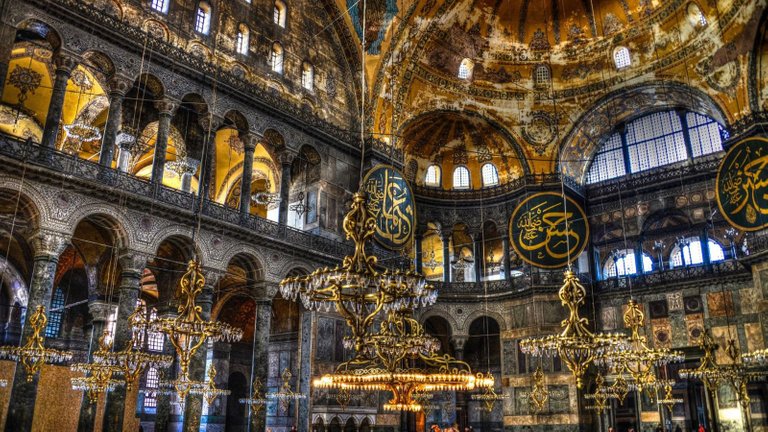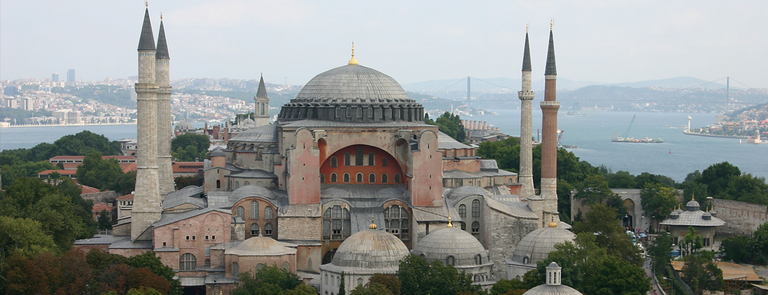Standing for 5 centuries, this building is among the chief works of art history and architecture and has become a symbol of Byzantine architecture with its big dome. Hagia Sophia is distinguished from other cathedrals by the following features:
It is the oldest cathedral in the world.
It has occupied the world's largest cathedral title for nearly a thousand years (until the completion of the construction of the Seville Cathedral in Spain in 1520) from the time it was built. Today it ranks fourth in terms of face measurements.
It is the fastest cathedral in the world (built in 5 years).
It is one of the constructions of the world's longest (15th century) place of worship.
The dome is considered the fourth largest dome in terms of diameter among the "old cathedral" domes.

The construction of the first Hagia Sophia was initiated by the Roman emperor Great Constantine (Constantine the first emperor of Byzantine Empire), who declared the official religion of the Christian empire. Son of the Great Constantine, who was on the throne between 337 and 361 II. It was completed by Constantius and the opening of the Hagia Sophia Church was carried out by Constantius II on 15 February 360. [16] It is learned from the records of Socrates Scholasticus that the first Hagia Sophia, decorated with silver-plated curtains, was built on the Temple of Artemis. [4]
The name of the first Hagia Sophia Church, meaning "Great Church", was Magna Ecclesia in Latin and Megálē Ekklēsíā (Μεγάλη Ἐκκλησία) in Greek. [4] It is stated that an old temple [note 3] was built [17] and there is no trace of this building that arrives daily.
This First Hagia Sophia was built near the imperial palace (near the new toilets, the new part of the present museum area, closed area) at the time of the St. Irene Church, which functions as a cathedral until the construction of the building is completed. Both churches functioned as the two main churches of the Byzantine Empire.
The first Hagia Sophia was a columned basilica in the style of traditional Latin architecture, with a wooden roof and an atrium in front. Even this first Hagia Sophia was extraordinary. On June 20, 404, this first church was burned and largely destroyed during the rebellions following the expulsion of Constantinople Patriarch St. Ioannis Hrisostomos from exile due to clashes with Emperor Aelia Eudoksia, wife of Emperor Arcadius.

After the first church was burned down during the rebellions, the emperor II. Theodosius ordered the construction of a second church at the time of the present Hagia Sophia, and the opening of the Second Hagia Sophia took place on October 10, 415. [13] This Second Hagia Sophia built by architect Rufinos was again a basilica plan, a wooden roof and five naves. It is believed that the second Hagia Sophia was hosted together with Hagia Irini of the First Istanbul Consul, the Second Ecumenical Council in 381. [18] This structure was burned and destroyed during the Nica riot on 13 January 532. [2] [19]
In the western avion of the building in 1935 (today's introduction) A.M. Many excavations of this second Hagia Sophia were seized during the excavations carried out by Schneider. These finds, which can be seen in the garden next to the main entrance of Ayasofyan today, are portican remains, columns, hoods and marble blocks, some of which are embossed. They were once found to be fragments of a triangular pediment embellishing the facade part of the building. The lamb reliefs on a block decorating the front of the building were made to represent 12 ainari. In addition, the excavations revealed that the floor of the Second Hagia Sophia was located two meters below the floor of the Third Hagia Sophia. The length of the second Hagia Sophia is unknown, but 60 m. [4] (The floor of the Second Hagia Sophia's staircase steps next to the main entrance of the Third Hagia Sophia can be seen thanks to the excavations.) The excavation did not continue because the current building may cause collapse.

istanbul amazing city
thank you
türkçe biliyormusun bir kaç soru sormalıyım sana
evet biliyorum türküm buyrun